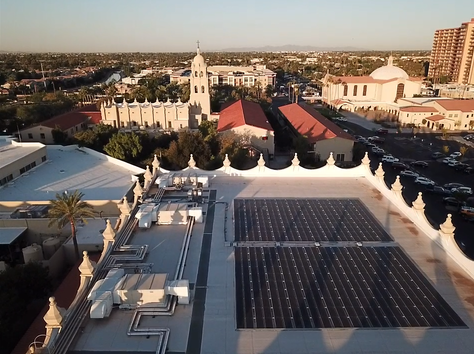Photo by George Anton ’21: The solar panels on Robson Gymnasium installed in 2001.
George Anton ’20
THE ROUNDUP
As schools around Arizona work to be more sustainable, Brophy has done so by implementing resource conservation programs to limit the amount of electricity and water the school uses.
With all of the lights, the forever-drenched winter lawn, and the air conditioners often running, it is easy to question if Brophy is a sustainable school.
According to Mrs. Mazier, “A few years back we had a Ph.D. candidate form ASU’s School of Sustainability who came and worked with us once a week. He was really impressed with us and said that for a school, Brophy was over the top with everything sustainable.”
According to Mrs. Sherri Stephens, the Director of Facilities at Brophy, there is an annual budget of $425,000 for electricity.
Although this budget satisfies all of Brophy’s electrical needs, the school still looks to reduce utility costs and maximize resource efficiency.
When asked about the solar on the Robson Gym, Mrs. Stephens said, “They have never been hooked up and do not work.”
They were originally installed in 2001 by a former parent that owned a solar company but turned out to never be viable.
It would be expensive and not worth it to try and fix them or take them down according to Mrs. Stephens.
“To make it worth it for the school to invest in solar they have to put up a lot of money up front. That is money that they do not have for operations,” said Mrs. Patty Mazier.
Mrs. Stephens mentioned that the only way for Brophy to go totally solar would be to put solar on every building on campus and create covered parking with solar in the south lot.
Brophy has postponed looking at the solar issue for the moment partly because they have no grant and Arizona Public Service (APS) does not currently offer any rebate on solar.
However, Brophy has taken other measures to reduce the amount of energy used, including double-paned windows to increase insulation, or a motion sensor light in female bathrooms that turns off the lights when those bathrooms are vacant.
The most successful way that Brophy has been able to save energy is by operating all air conditioners on campus through a computer.
Mrs. Stephens now manages all of the room temperatures from her desk.
This technology limits faculty and staff from changing the temperature of their classroom or office.
Keeping the temperature a couple of degrees cooler than room temperature can spike the cost of running the AC.
As a school in the desert, Brophy has looked to reduce the amount of water used on campus, especially in terms of watering the grass on campus.
The facilities department is granted $5,000 budget each year to supply all of the school’s water needs. Brophy has kept this budget low by utilizing all the ways in which they can increase water efficiency.
Since 1928, there has been a well right in the heart of campus in Graham Plaza.
This well supplies irrigation water for almost all the grass and is the water used for every sink and drinking fountain at Brophy.
“The water is very good. We all on campus drink it every day if we use the fountains,” said Mrs. Stephens.
Currently, all grass is irrigated using the well water except for Opus Field and the Brophy Sports Campus, which uses Salt River Project (SRP) water.
According to Mrs. Stephens, SRP water is cheaper and better because less is needed for grass compared to the water from the well.
To get access to direct SRP water, Brophy had to build to water vaults, one by the sports campus and the other on Xavier’s property.
The vault at Xavier is piped up to the front lawn. Eventually, Brophy will set up the pipes from the vault to water the front lawn and the rest of the campus so that all grass will be watered using SRP water.
“We could have hooked onto city water and paid exorbitant prices plus used water that wasn’t necessary,” said Mrs. Stephens.
By Brophy avoiding the use of city water, they have been able to reduce the amount of water used for the school’s landscaping.
Using the SRP water will lower water costs and increase irrigation efficiency.
Brophy’s SRP plan is set in motion to save water and will hopefully happen soon according to Mrs. Stephens.
Brophy has promoted many ways to reduce electrical and water waste and has also worked to limit the amount of waste on campus, whether it be by eliminating plastic bottles or having recycling bins.
However, Mrs. Tanea Hibler believes that Brophy’s recycling still has room for improvement because students often put trash in the blue bins on campus and do not know what can be recycled and what can’t.
Agreeing with Mrs. Hibler, Mrs. Mazier says, “We can always do more. Everybody can always do more, but what we are doing is pretty good.”
















